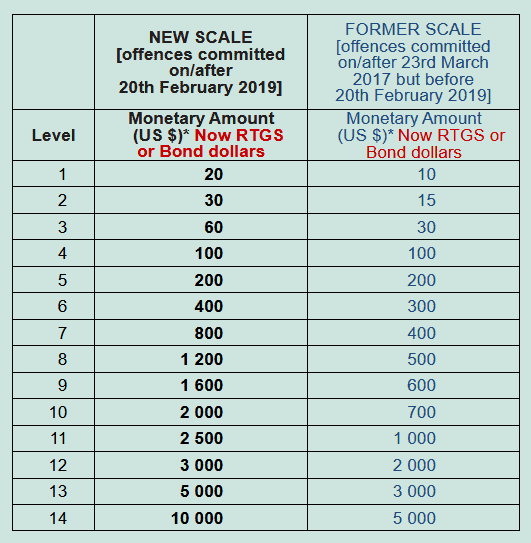Section 27 of the Finance Act, 2019 (No. 1 of 2019) introduced a new Standard Scale of Fines with effect from 20th February 2019, the date on which the Act was published in the Government Gazette and became law. The new standard scale is reflected in columns 1 and 2 of the table below.
The new standard scale applies only to offences committed on or after the date it became law, i.e. on or after 20th February [see section 280 of the Criminal Law Code]. We have therefore included the previous standard scale in the table below as column 3. The previous standard scale will continue to apply to offences committed before 20th February and on or after the 23rd March 2017 [the date it was introduced by Act No. 2 of 2017].

*US dollars?
“US$” in the headings to columns 2 and 3 in the table must be read as RTGS dollars or bond dollars.
Why? Because, according to section 4(1)(f) and (2) of SI 33/2019 of the Presidential Powers (Temporary Measures) (Amendment of Reserve Bank of Zimbabwe Act and Issue of Real Time Gross Settlement Electronic Dollars (RTGS Dollars)) Regulations, 2019 gazetted on 22nd February: Amounts stated in US dollars in all legislation must now be construed as references to RTGS dollars or bond notes on a 1:1 basis
Comment: The use of Presidential Powers is now being challenged in the High Court.
How the Standard Scale Works
In Zimbabwean legislation a typical penalty provision for an offence punishable by a fine will look like this:
“A person who carries on the business of … without a licence shall be guilty of an offence and liable to a fine not exceeding level six …”
The standard scale tells one the monetary amount of the maximum fine that can be imposed for a level six offence, which is $400 [RTGS or Bond] for an offence committed on or after 20th February this year and $200 [RTGS or bond] for an offence committed before that date but on or after 23rd March 2017.
The link between the words “level six” in the penalty provision is provided by the definitions of “level” and “standard scale” in section 3(2) of the Interpretation Act:
“level”, in relation to a fine, means a level on the standard scale;
“standard scale” means the standard scale of fines referred to in section 280 of the Criminal Law Code, as amended or replaced from time to time.
The standard scale referred to in section 280 of the Criminal Law Code is the scale set out in the First Schedule to the Code. And it is this First Schedule that was repealed and replaced by section 27 of the Finance Act [referred to in line 1 of this bulletin].
When imposing a sentence of a fine, of course, a court must state the amount of the fine as a sum in dollars [now RTGS or bond] not exceeding the relevant level.
The New Standard Scale and Admission of Guilt Fines [aka “spot fines”]
The heading to section 356 of the Criminal Procedure and Evidence Act is “Payment by accused persons of fines which may be imposed for minor offences in lieu of appearance in court”.
Section 356 allows a police officer to invite a person accused of a minor offence to pay an admission of guilt fine if the “officer has reasonable grounds for believing that the court which will try the said person for such offence will, on convicting such person of such offence, not impose a sentence of imprisonment or a fine exceeding level three”.
The effect of the new standard scale is that the maximum admission of guilt fine for a minor offence is now $60 [RTGS or bond] – the new level 3 – but this applies only to offences alleged to have been committed on or after 20th February 2019. For offences alleged to have been committed before 20th February 2019 and on or after 23rd March 2017, the maximum admission of guilt fine remains at $30 [RTGS or bond] – the previous level 3.
In deciding the amount of an admission of guilt fine, a police officer is usually guided by a schedule of deposit fines issued by the Chief Magistrate’s Office specifying offences for which the admission of guilt procedure may be used and indicating the amounts of the fines likely to be imposed by a court.
Does Paying an Admission of Guilt Fine Result in a Conviction?
As a general rule, signature of the relevant admission of guilt form and payment of the requested fine enables an accused person to avoid appearing in court. But the police must submit every admission of guilt form to the clerk of the magistrates court, where each such case must be entered in the court records and, if confirmed by a magistrate, recorded as a conviction and fine imposed by the court. Exceptionally, a magistrate may refuse to confirm an admission of guilt, in which case no conviction is recorded and the fine paid must be returned to the accused and the police may, if so advised, prosecute in the ordinary way. If the magistrate reduces a fine, the conviction remains on record but the difference must be returned to the accused.
Source: Veritas







